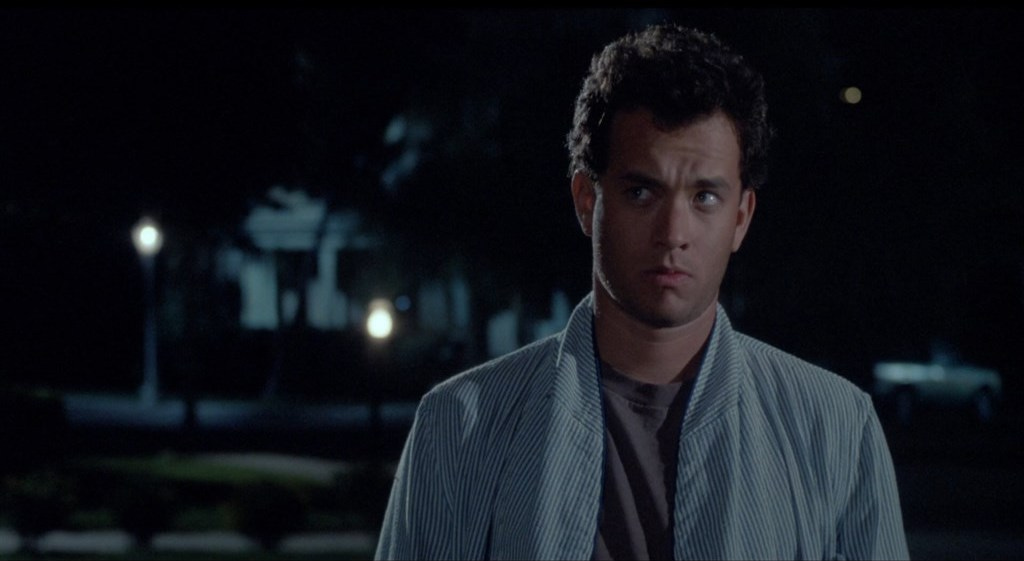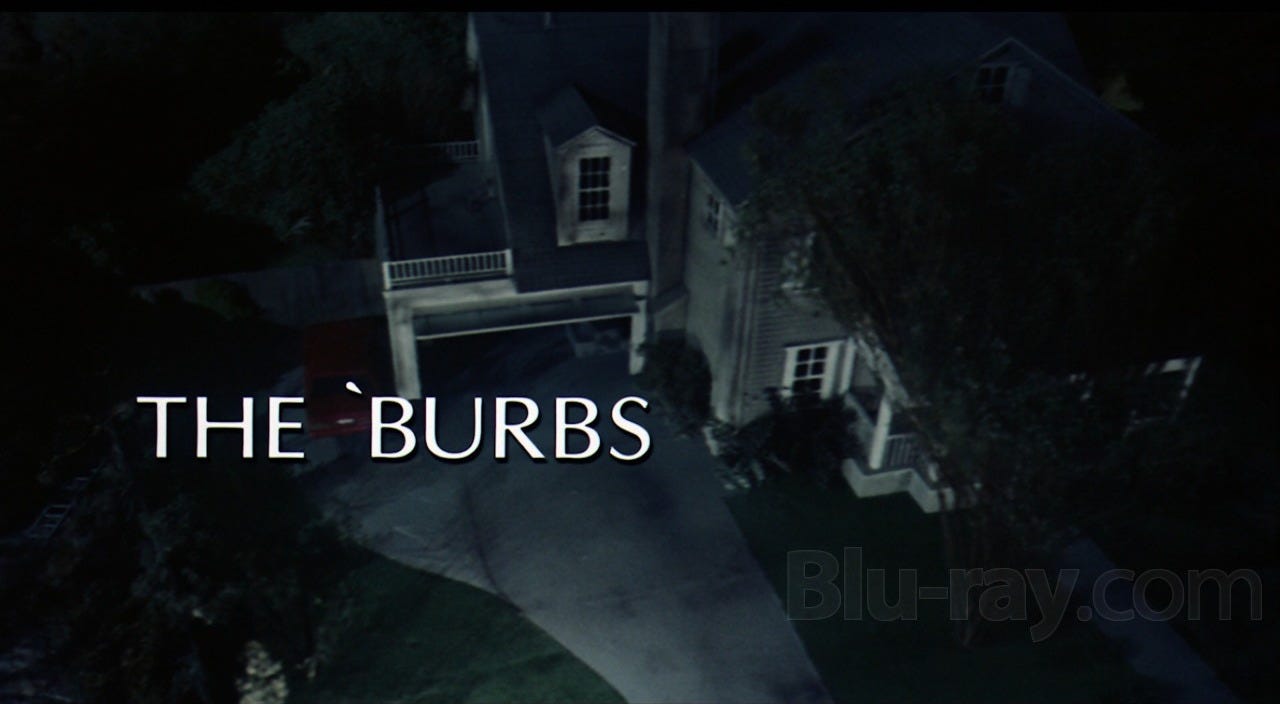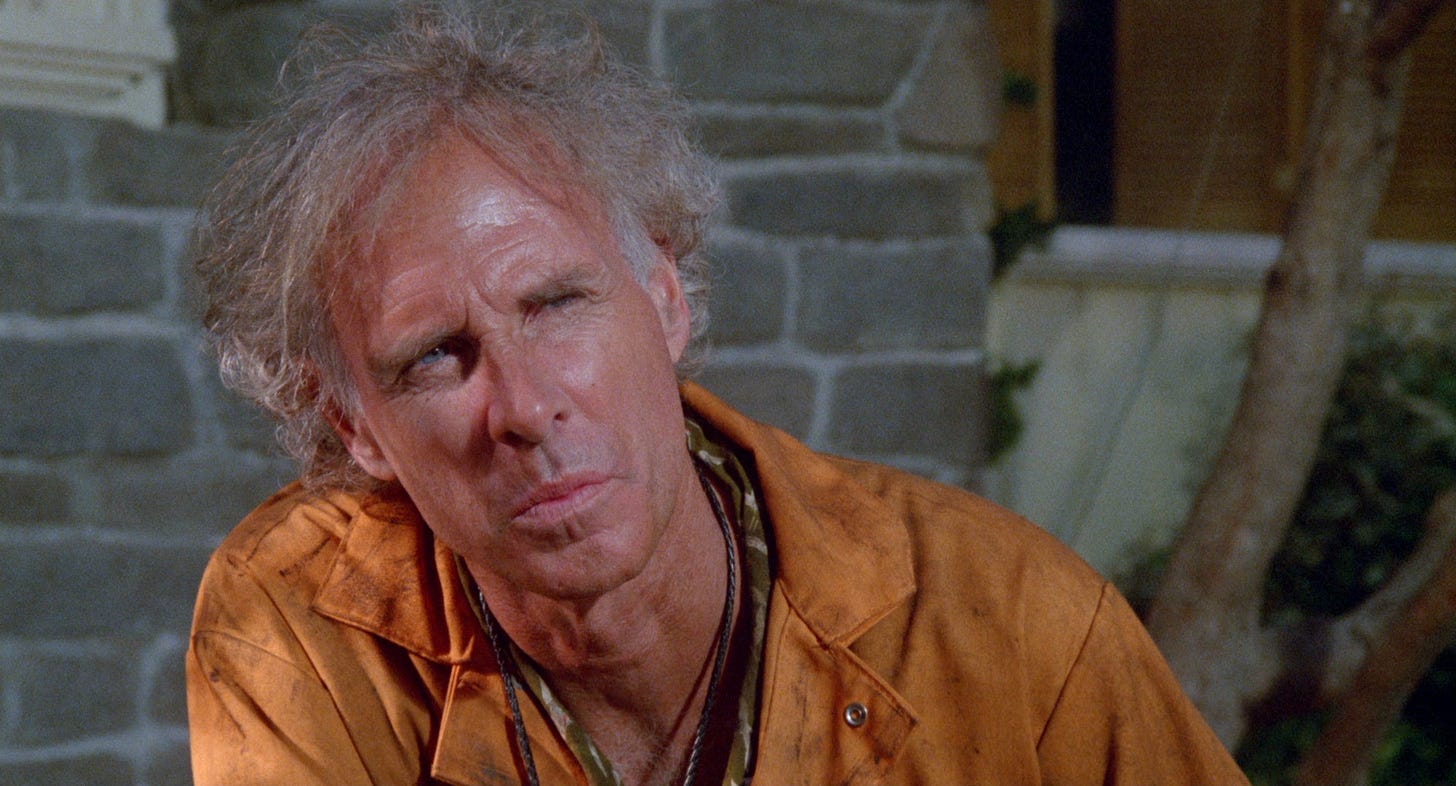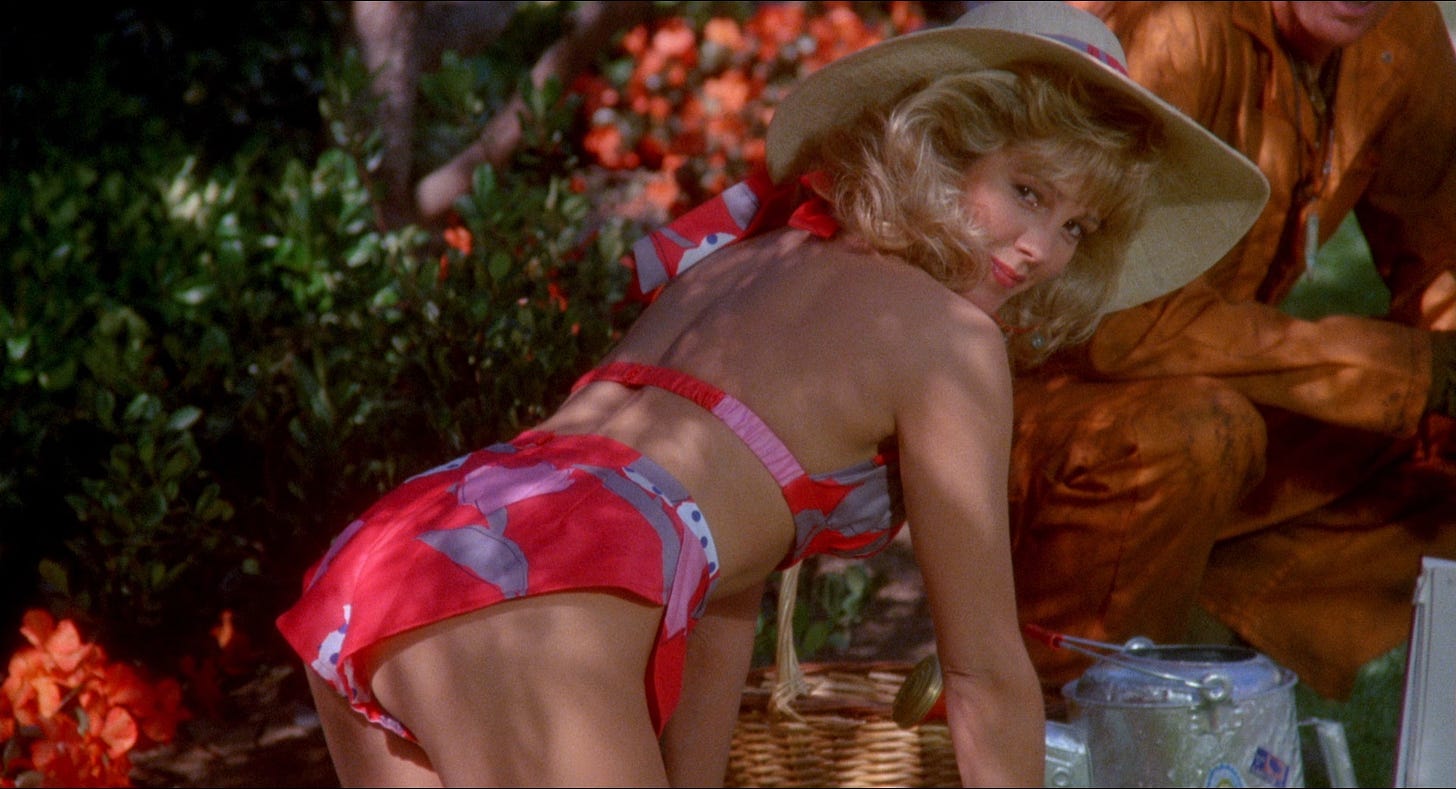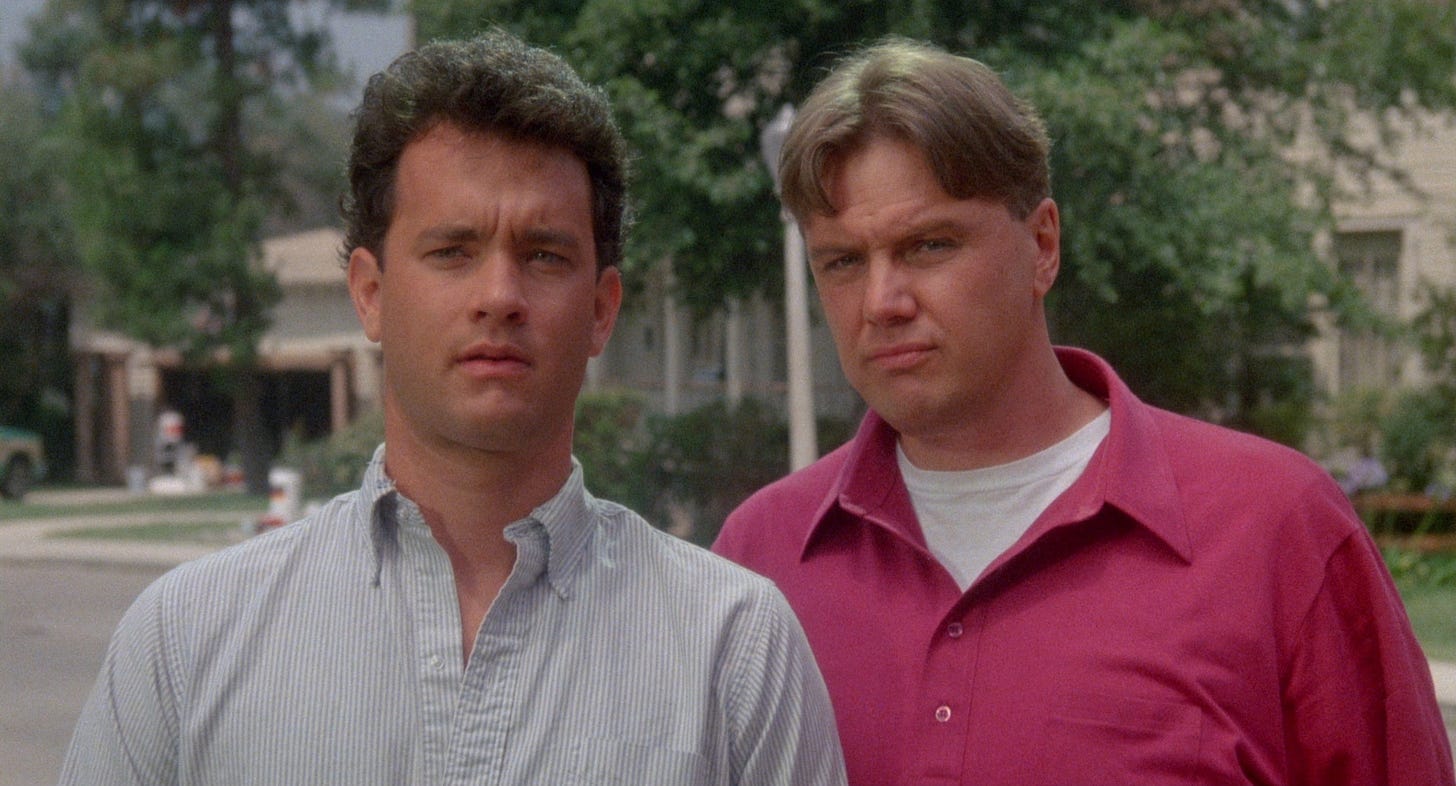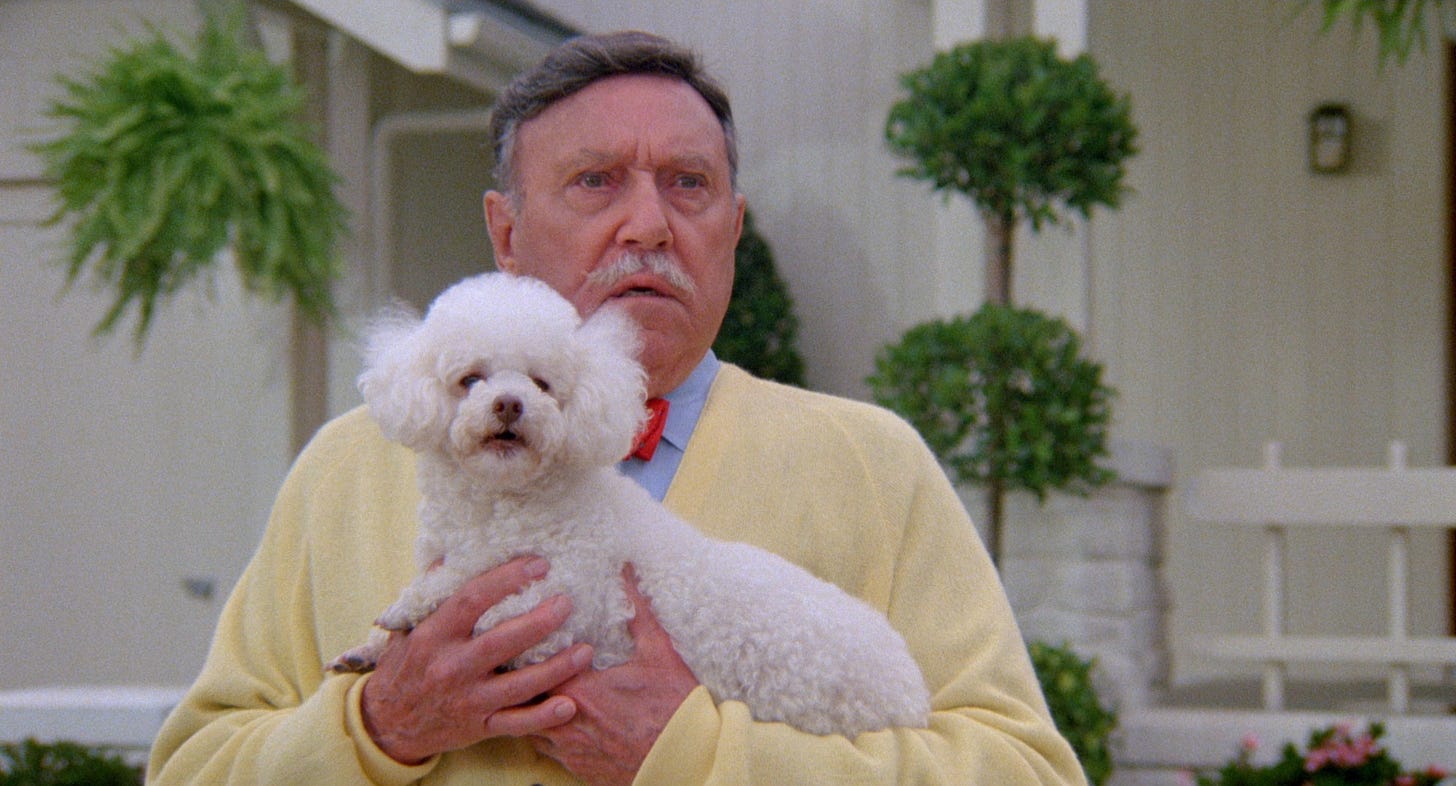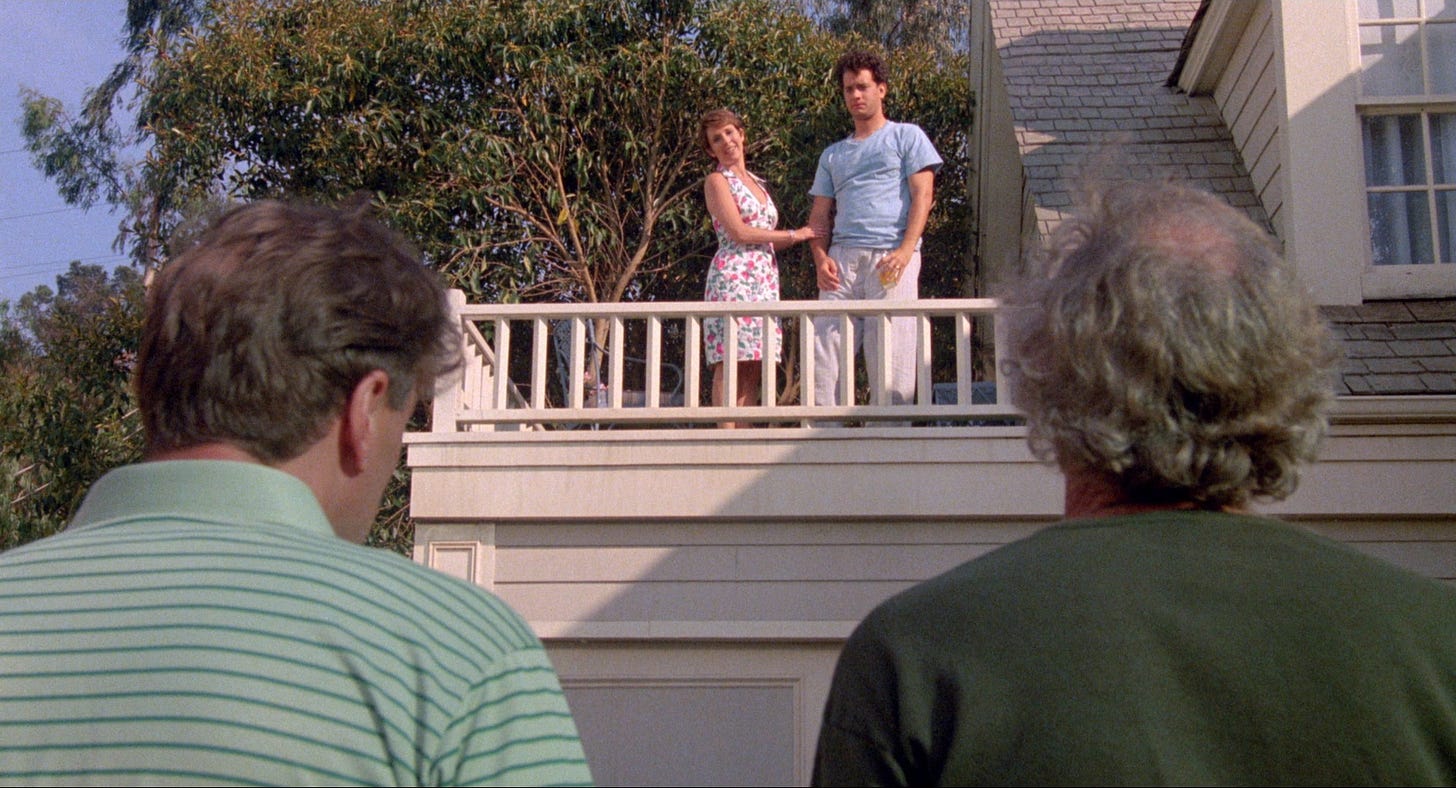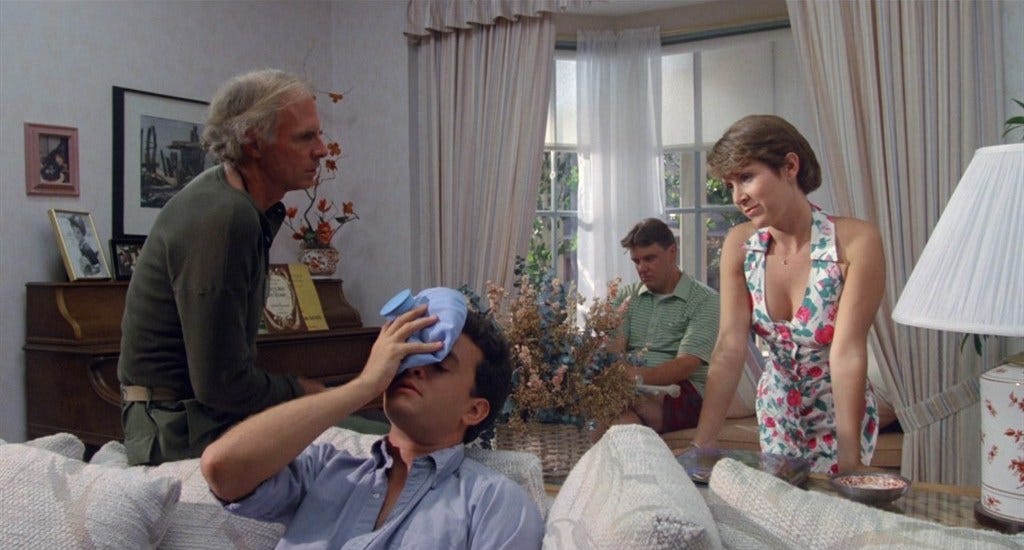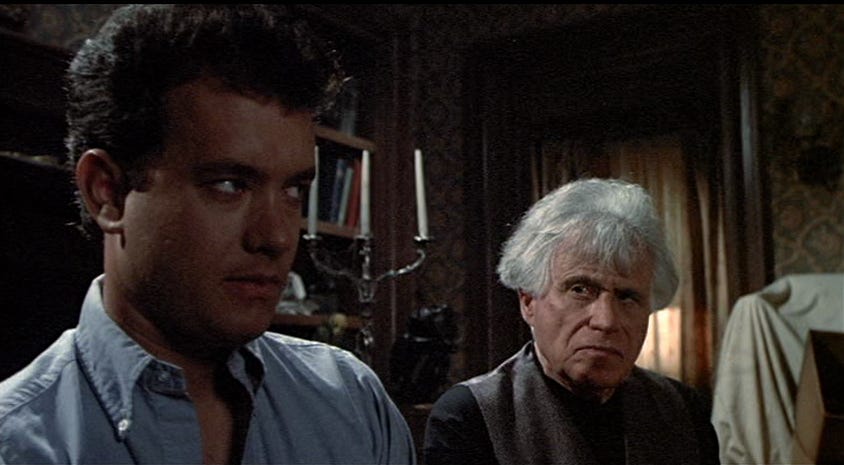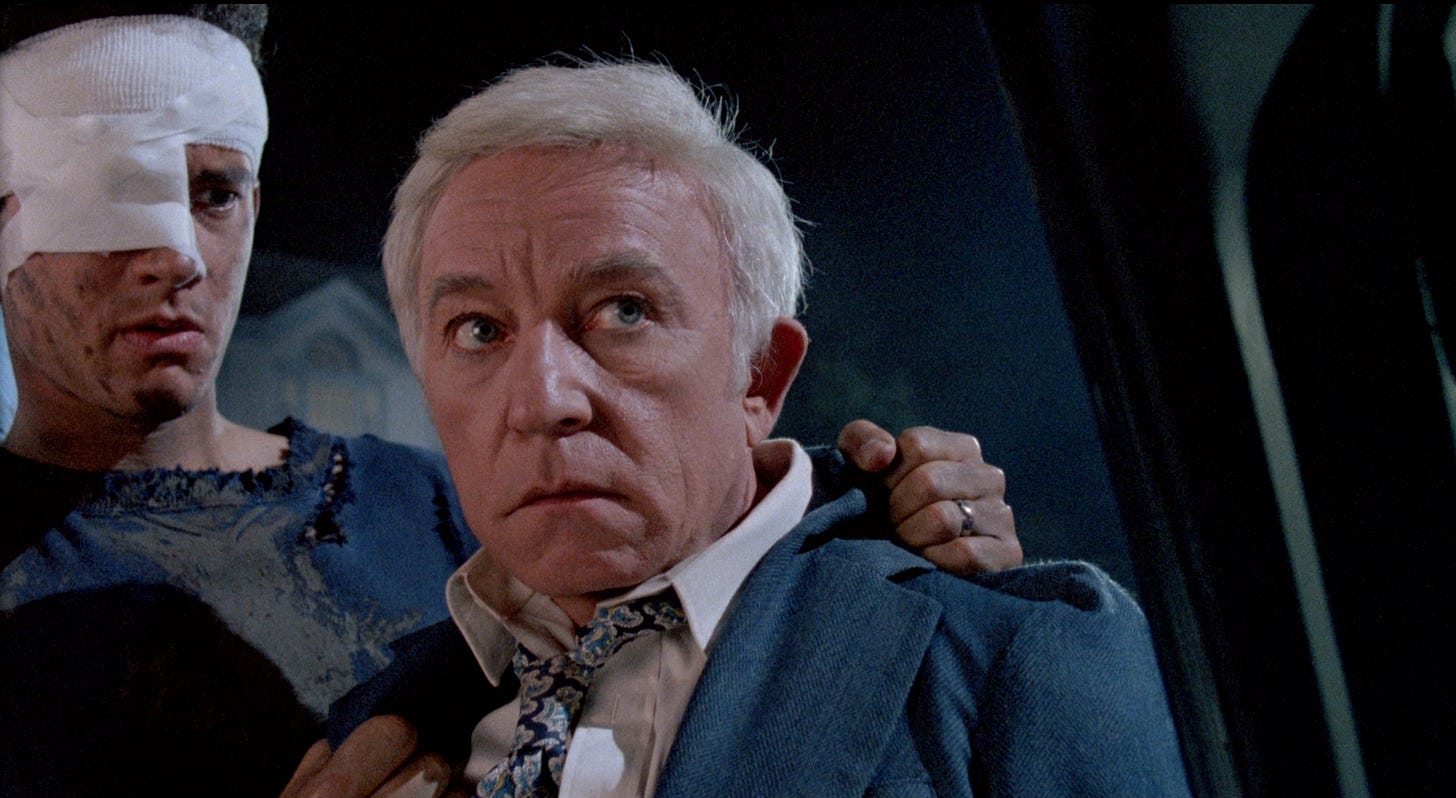In the month of October, Video Days is looking out for scaredy cats, counting down to All Hallows’ Eve with ten horror movies in ascending scariness.
THE ‘BURBS (1989) proceeds as if delinquents stole some recording equipment and using a cul-de-sac as a backlot, made a movie without adult supervision. As if it wasn’t enough of a challenge–kings of comedy like Mel Brooks or Zucker/ Abrahams/ Zucker having already done it–they don’t spoof Alfred Hitchcock, but thumb their nose at convention in general with this cult comedy/ horror picture. Its bizarre sensibility is infectious, several performances brilliant, and the attempt at something different admirable, even as the movie doesn’t really work.
Dana Olsen grew up in Evanston, Illinois and with two older sisters, spent a lot of time in his room, reading Mad magazine and drawing. Publishing one of his cartoons in the high school newspaper got Olsen invited to perform in a student variety show. From there, he never took any other career pursuit but show business seriously. At seventeen, he was performing standup comedy in Chicago nightclubs. Olsen chose to attend Northwestern University because in the mid-1970s, they had a decent film program. He auditioned for and was accepted into a campus improv revue modeled after Second City called The Mee-ow Show, which would count Julia Louis-Dreyfus (class of 1983), Seth Meyers (1996) and Kristen Schaal (2000) as future members. When alumni Garry Marshall–writer/ producer/ creator of Happy Days, Laverne & Shirley and Mork & Mindy–visited Northwestern, Olsen got to know the television titan. The college senior wanted to give standup comedy a shot in Los Angeles, but figured that writing would be a good backup. With his connection to Marshall, he wrote a Laverne & Shirley script on spec. Two weeks before Olsen graduated in 1980, his Laverne & Shirley script got him a job as a staff writer on the show, at the Paramount Studios lot in Hollywood.
Relocating to L.A. at a time of back-to-back Writers Guild strikes–in July-October 1980 and April-July 1981–Olsen started cranking out scripts when there wasn’t a lot of new material being passed around. He partnered with his roommate Michael Spound to pen a slasher movie parody titled The Lawnmower Killer, which was (rewritten) and produced as Wacko (1982) starring Joe Don Baker. Olsen’s next strike script was a kaiju parody titled Godzilla vs. Cleveland. This led to comic/ writer/ director David Steinberg commissioning Olsen to write Going Berserk (1983), a comedy featuring most of the SCTV cast who were available: John Candy, Eugene Levy, Joe Flaherty. Continuing to write on spec, Olsen reached back to his childhood in Evanston, where the true crime of the times seemed to periodically expose homicidal maniacs living down the block. He pictured his story as The Adventures of Ozzie and Harriet meets the Manson Family. Written as a half-hour television pilot titled The Sheriff of Maple Street, Olsen sold it to CBS, where his script came close to being produced, but wasn’t. Olsen felt strongly enough about the material to compel the network to revert full rights back to him, and CBS did. This allowed Olsen to expand The Sheriff of Maple Street into a feature-length screenplay he retitled Bay Window. Hitchcockian comedies were having a moment, Foul Play (1978), 9 to 5 (1980) and Hanky Panky (1982) mining laughs out of criminal conspiracy and paranoia. Olsen’s script became his calling card in features.
Larry Brezner, producer of Throw Momma From the Train (1987) and Good Morning, Vietnam (1987), was partner in a management firm that represented Billy Crystal, Robin Williams and David Letterman among other comics. Brezner optioned Bay Window and with Billy Crystal attached to star, sold the script to producers Ron Howard and Brian Grazer, who’d co-founded Imagine Entertainment in 1985 and at that time had a production deal with TriStar Pictures. They lined up Rod Daniel, who’d directed a moderately successful comedy for Imagine in Like Father, Like Son (1987), but Billy Crystal lost interest, choosing to star in a father-son comedy he’d co-written and would co-produce as well as star in: Memories of Me (1988). Imagine’s deal with TriStar ended and Bay Window might have ended with it. When Howard and Grazer finalized a long-term, multi-picture agreement with Universal Pictures in December 1987, another looming labor strike made any script that was ready to shoot a commodity. Bay Window was one of those scripts.
In February 1988, Imagine sent Bay Window to Joe Dante, who’d cut the first movie Ron Howard had directed, Grand Theft Auto (1977), when the king of the indies Roger Corman was giving them both on-the-job training as filmmakers. Dante had since directed one manic horror movie after another, often slipping in more than the plot required with cheeky wit: Piranha (1978), The Howling (1981), Gremlins (1984) and the segment of Twilight Zone: The Movie (1983) in which an omnipotent but lonely boy imprisons wayward travelers in a Looney Toons universe of his making. Dante had been one month from directing a quirky drama for Fox titled Little Man Tate about a child prodigy raised by a single mother in her twenties. He’d completed casting for the boy, but walked away when the studio insisted they cast Cher as the mom, which would’ve turned Little Man Tate into a movie about a parent still figuring things out in her forties. Dante didn’t particularly read Bay Window as a commentary on Alfred Hitchcock thrillers, nor was he interested in making one. What he could relate to and wanted to make was a comedy about weird neighbors, or at least our obsession with them. The more people Dante and his producing partner Michael Finnell talked to about the script, the more mentioned growing up near a house with reclusive characters that everyone else in the neighborhood was suspicious of. Dante and Finnell came aboard to direct and produce, respectively, and when Ron Howard, assuming the role of executive producer, landed the actor he and Brian Grazer had made a star in Splash (1984), Universal greenlit the film with Tom Hanks starring. Their project would be retitled The ‘Burbs.
Hanks was unsure whether he was ready to play a dad and perhaps be typecast as one forever, but rather than spend the summer of 1988 without work while the WGA went on strike, he took the job. Casting directors Mike Fenton and Judy Taylor, who’d worked with Dante and Finnell on their previous film Innerspace (1987), helped assemble an A-cast. Bruce Dern, Carrie Fisher and Rick Ducommun (whose manager Larry Brezner was producing The ‘Burbs with Finnell) joined actors Dante had worked with previously: Wendy Schaal in Innerspace, Corey Feldman in Gremlins and appearing as garbage men, Robert Picardo and Dick Miller, who’d popped up in nearly every film Dante had made. To play the Klopeks, three generations of strange men who move into the nameless neighborhood, the filmmakers went 3-0 with Henry Gibson, Courtney Gains and Theodore Gottlieb. The latter was a Holocaust survivor who came to America and as “Brother Theodore” embarked on a career in the performing arts, leaning into theater of the absurd as the voice of Gollum in the animated The Lord of the Rings (1978) and as a guest on Late Night with David Letterman in the early eighties. Imagine had anticipated filming exteriors for The ‘Burbs in a real cul-de-sac somewhere in the midwest, but the impracticality of homeowners signing off on a neighboring home being blown to bits nixed that plan.
Instead, The ‘Burbs was shot on the Universal Studios backlot in Los Angeles, specifically, Colonial Street, the suburban facade which since moving to the south side of the lot in 1981 had been seen on television shows needing a suburban block: Simon & Simon, Murder, She Wrote, The New Leave It To Beaver. Rather than realism, the eerie familiarity of the location was exactly the feeling Dante wanted. Shooting commenced in May 1988, less than three months after Dante and Finnell were handed the script. The WGA strike had begun March 7 and would stretch to August 7 and during that time, The ‘Burbs was the only show filming on the Universal lot. An advocate of having the writer on the set, Dante gave Dana Olsen a tiny role as a police officer, the screenwriter barred by union regulations from taking writing jobs during the strike, but less policed when it came to issuing “suggestions” to anyone in earshot. Dante mostly took advantage of booking a superb cast for the same duration in the same location to shoot The ‘Burbs in sequence, allowing the actors to build their characters as filming progressed, more like a play than a movie.
Hanks determined the reason his character Ray Peterson had elected for a “staycation” was that he’d been fired from his job and hadn’t told his wife, played by Carrie Fisher (references to Ray’s job loss would end up on the cutting room floor, as well as a dream sequence in which Dante regular Kevin McCarthy appeared as Ray’s boss). One of the funniest lines in the movie–delivered off-camera by Bruce Dern to Brother Theodore–was improvised by Dern. A few weeks into filming, Big (1988) grew into a summer blockbuster, generating chatter that Tom Hanks could garner his first Academy Award nomination (he would, for Best Actor). Universal took advantage of Hanks’ popularity to open The ‘Burbs on President’s Day weekend, February 17, 1989, on 1,956 screens in the U.S. This was a wider release than Lethal Weapon 2 or the new James Bond film, License To Kill, would book that summer. The ‘Burbs would not only receive some of the worst reviews of the year, but the worst reviews its writer or director would ever receive. Gene Siskel & Roger Ebert, reviewing the film after it opened atop the box office, gave it two thumbs down. Siskel proposed that Tom Hanks was too smart for this story, a parody of suburbia the critic couldn’t admit laughing with once. Ebert pointed out its similarities to the John Belushi-Dan Aykroyd black comedy Neighbors (1981), which both critics liked. Of The ‘Burbs, Ebert said, “This movie is bankrupt of imagination, it goes nowhere, it uses a lot of special effects to no avail.”
Writing in the New York Times, Vincent Canby quipped, “The movie is as empty as something can be without creating a vacuum.” Joe Dante carried that line around in his head for thirty years, joking that The ‘Burbs got the worst reviews since Mein Kampf. Its only competition Bill & Ted’s Excellent Adventure (1989), a comedy without stars that had been locked away in a vault for a year, The ‘Burbs opened #1 at the box office its first two weekends in release. It would spend only four weeks among the top ten grossing films in the U.S., fair to middling word of mouth hurting its commercial longevity. Viewers who discovered the movie on videocassette or cable television—often in the ‘burbs themselves—embraced it. Along with Gremlins and Innerspace, the latter of which was also revived by steady rotation on HBO, The ‘Burbs is the movie Dante is most often invited to discuss at retrospective screenings or asked about on podcasts, and with Splash and Big, the most popular movie Tom Hanks made during his first decade as a film leading man.
At its best, The ‘Burbs is—with the exception of They Live (1988), another film that proposed something weird was going on behind the curtain in America–the most bizarre movie Universal distributed in the late eighties. In terms of originality, it stands out among the comedies Imagine would begin to churn out for the studio, like The Dream Team (1989) or Parenthood (1989), The “Burbs also being the first. With a script by Dana Olsen whose dialogue is the furthest from sharp, Tom Hanks gives a performance quietly reminiscent of Buster Keaton or a silent movie comedian. His great moments aren’t just funny-sneeze coughing in an allergic chain reaction to sardines, descending porch steps three at a time while in a semi-catatonic state–they’re pulled off without him uttering a word. Bruce Dern and Wendy Schaal–playing the block’s other couple, a Vietnam vet wrapped too tight for the ‘burbs and his Barbie doll wife, respectively–are funny too. Carrie Fisher was a steal as Hanks’ wife. Having worked with him on The Man With One Red Shoe (1985), Fisher is as comfortable around him as a wife would be her husband, but more importantly, was launching her career as a script doctor, tasked with performing triage on scripts with pedestrian female characters. In The ‘Burbs, Fisher fixes her own character, giving her autonomy, neither getting in her husband’s way, nor helping him.
Unfortunately, Fisher didn’t write the script. Olsen tries to squeak by manufacturing familiar situations–the obnoxious neighbor tolerated out of necessity, the dog that uses neighbors’ lawns for a toilet, the paperboy with bad aim–and passing them off as funny, when they’re just recognizable. An honest way to describe The ‘Burbs would be to compare it to The Addams Family if the Addamses were the villains and their dull neighbors were depicted as heroes. Hanks and Fisher’s characters are saddled with a 10-year-old son who adds nothing to the story. Hanks, five years removed from Bachelor Party (1984), seems to rebel against playing scenes as a dad. Corey Feldman, second to Hanks as the biggest star at that time, is out of his depth, unable to find his character–a stoner, a zoner, a geek, a wannabe?--without being written one. He’s reduced to telling the viewer how much his character loves his street, something no human being would ever say and like much of the film, is forced. Dante plays everything big, without a big story to support it. Jerry Goldsmith, scoring his fifth picture for Dante, earned his pay with a whippy musical score in search of a comedy as smart as its director.
Video rental category: Comedy
Special interest: The ‘Burbs


